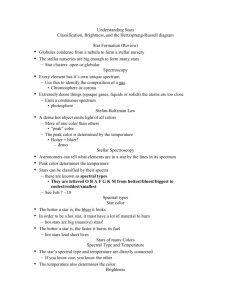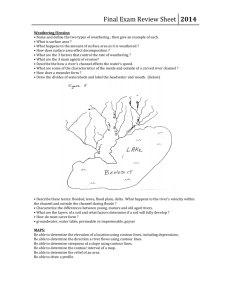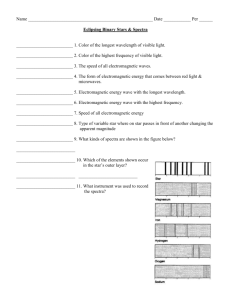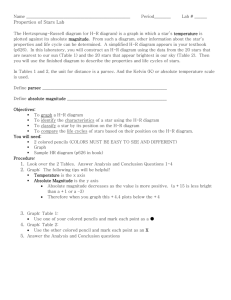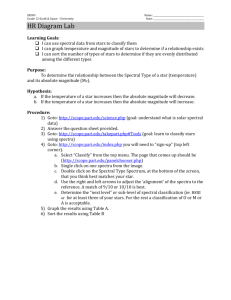H-R diagram
advertisement
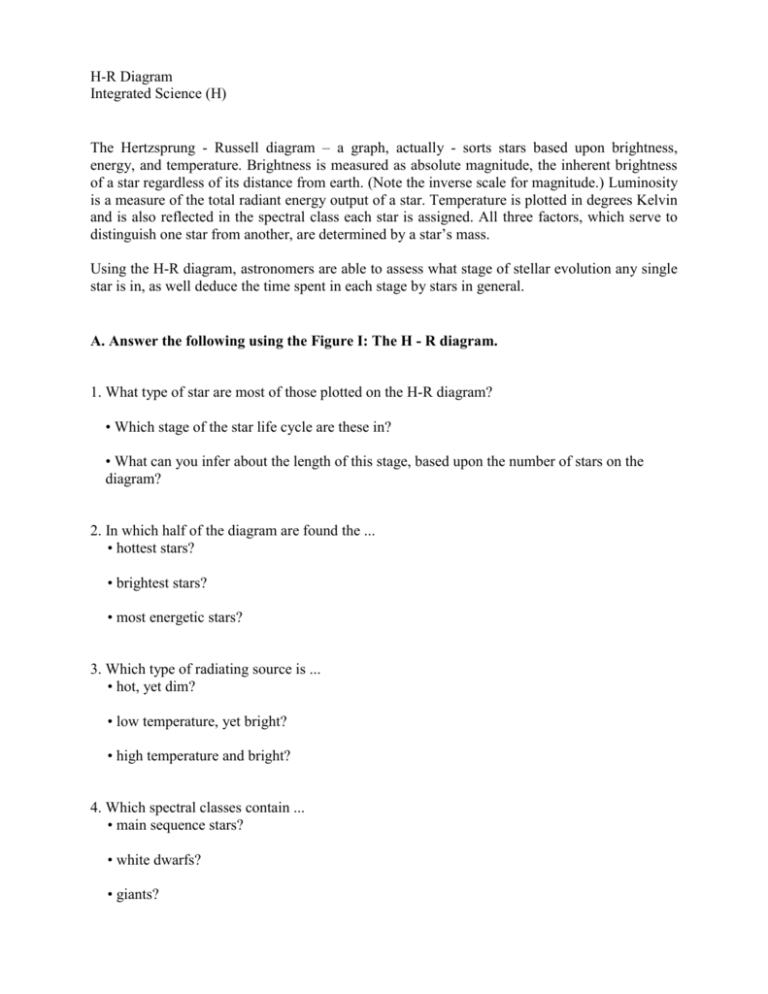
H-R Diagram Integrated Science (H) The Hertzsprung - Russell diagram – a graph, actually - sorts stars based upon brightness, energy, and temperature. Brightness is measured as absolute magnitude, the inherent brightness of a star regardless of its distance from earth. (Note the inverse scale for magnitude.) Luminosity is a measure of the total radiant energy output of a star. Temperature is plotted in degrees Kelvin and is also reflected in the spectral class each star is assigned. All three factors, which serve to distinguish one star from another, are determined by a star’s mass. Using the H-R diagram, astronomers are able to assess what stage of stellar evolution any single star is in, as well deduce the time spent in each stage by stars in general. A. Answer the following using the Figure I: The H - R diagram. 1. What type of star are most of those plotted on the H-R diagram? • Which stage of the star life cycle are these in? • What can you infer about the length of this stage, based upon the number of stars on the diagram? 2. In which half of the diagram are found the ... • hottest stars? • brightest stars? • most energetic stars? 3. Which type of radiating source is ... • hot, yet dim? • low temperature, yet bright? • high temperature and bright? 4. Which spectral classes contain ... • main sequence stars? • white dwarfs? • giants? B. Apply the H-R diagram to the brightest stars from Earth, listed in Table I. 5. Plot any 5 stars onto the H-R diagram. Have your partner do a different 5. You’ll need to add in increments 1-9 for each spectral class. • Which stage of life are most of these brightest stars in? Infer why there are few dwarfs in the group. 6. Apparent magnitude describes how bright a star appears to us on Earth. • Which of these stars looks brightest to us? • Compare and contrast the apparent and absolute brightness of Vega and Capella. Infer why these two stars differ. 7. Use the spectral class and apparent magnitude data to determine which star ... • is hottest? • has the greatest absolute magnitude? • is least luminous (energetic)? Follow Up: 1. What accounts for the fact that some main sequence stars are hot & bright, and others cool & dim? 2. How can a main sequence star be as bright as a giant? 3. Why are most stars on the main sequence? 4. Your cousin, a neophyte stargazer and the family know-it-all, claims that Rigil Kentaurus is the biggest and brightest star in the sky. Diplomatically correct him. 5. Create a mnemonic to remember the sequence of the spectral classes. Extension: HR interactive: http://astro.unl.edu/naap/hr/animations/hr.html FIGURE I: The Hertzsprung-Russel Diagram TABLE I: Brightest Stars as Seen From Earth Name Sirius Canopus Rigil Kentaurus Arcturus Vega Capella Rigel Procyon Betelgeuse Achernar Hadar Altair Aldebaran Acrux Spica Antares Fomalhaut Pollux Deneb Beta Crucis Apparent magnitude (negative = brighter) -1.47 -0.72 -0.01 -0.06 0.04 0.05 0.14 0.37 0.41 0.51 0.63 0.77 0.86 0.90 0.91 0.92 1.15 1.16 1.26 1.28 Spectral class A1 F0 G2 K2 A0 G8 B8 F5 M2 B3 B1 A7 K5 B2 B1 M1 A3 K0 A2 B0.5 Absolute magnitude (negative = brighter) 1.4 -3.1 4.4 -0.3 0.5 -0.6 -7.1 2.7 -5.6 -2.3 -5.2 2.2 -0.7 -3.5 -3.3 -5.1 2.0 1.0 -7.1 -4.6 Distance (ly) 8.7 98 4.3 36 26.5 45 900 11.3 520 118 490 16.5 68 260 220 520 22.6 35 1600 490



